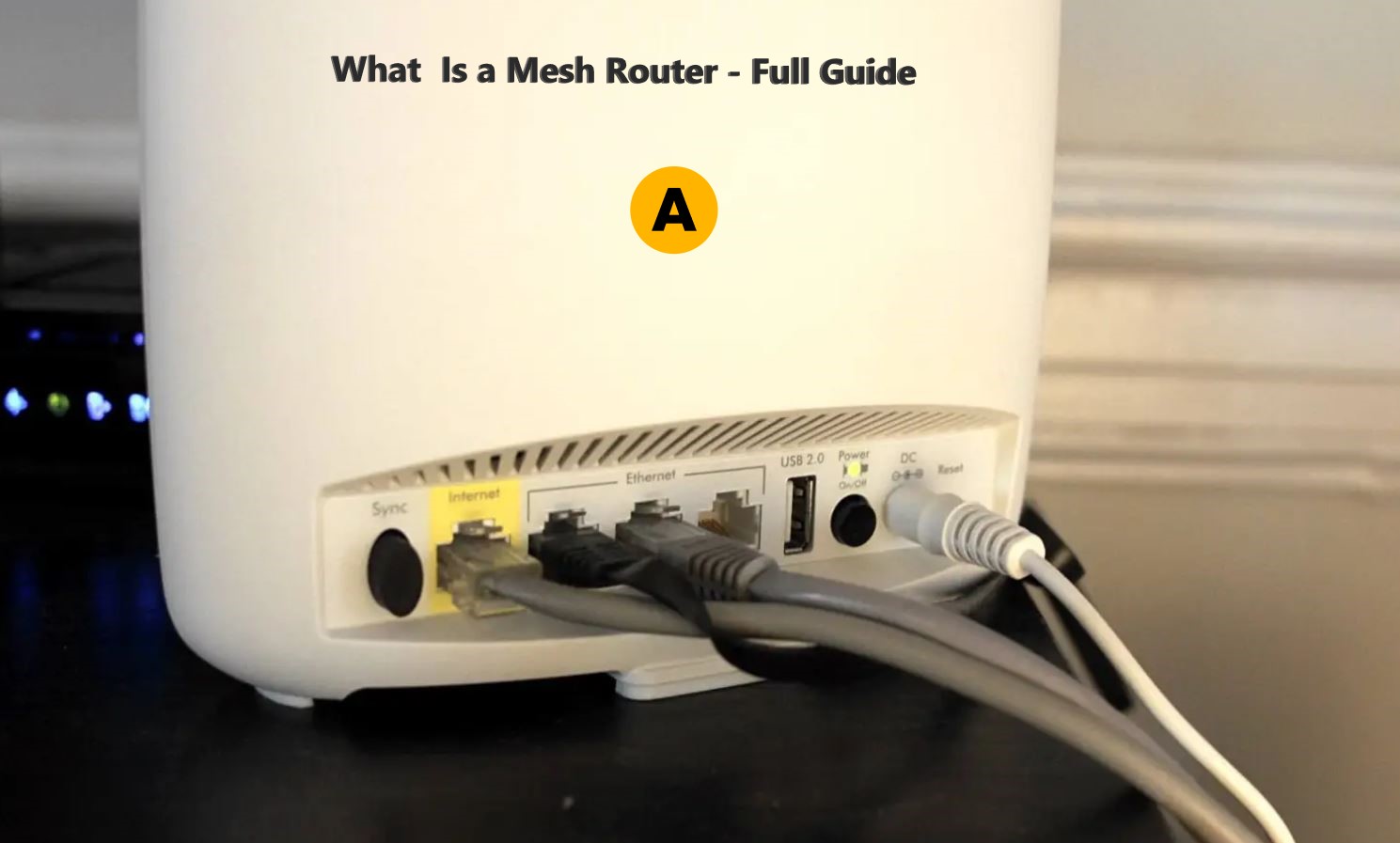Hey Explorer! Are you searching about mesh router, so this blog is for you as I have concluded all the aspects about mesh router and it will also help you to eliminate the dead zones in your home.
Many customers report inadequate WiFi signals in certain portions of their homes. This usually occurs in residences that are excessively large or separated into many sections. Generally, you would use a WiFi extender to improve WiFi access in remote sections of your home. However, there is another alternative you can consider. You can use a mesh router to eliminate dead zones in your wireless network. The WiFi mesh network gives strong WiFi connections around your home.
For example, Google WiFi or Google Mesh Router provides seamless WiFi connectivity and a large coverage area. It uses mesh WiFi technology to provide fast bandwidth and a steady internet connection. This router allows you to effortlessly create additional points to extend WiFi coverage across your home.
Mesh WiFi routers are often used in larger houses. They are also utilized in homes with brick walls between rooms that are large enough to obstruct WiFi signals. This article will help you understand mesh routers and why they are superior to traditional WiFi routers.
How Mesh Router Works

Viewing movies, playing games, and watching live sports all be a problem if your WiFi connectivity is inadequate. A poorer internet connection can also be the reason for the low connectivity troubles.
However, if you are encountering connectivity troubles only in particular portions of your home, the problem can be your old router. Weak WiFi transmissions in particular regions can cause WiFi dead zones. These zones are frequently created in those places that are far distant from the router. It can also occur in residences with multiple stories.
The network range of a standard router normally spans between 150 to 300 feet. The range diminishes if there are several walls or barriers in front of the WiFi router.
WiFi mesh routers rebroadcast the main network to increase coverage. It links many nodes i.e. internet access points to improve the WiFi signal. A single node serves as the hub, while the others are like satellites in orbit. The primary or primary node has an unmediated connection to the modem.
The mesh router grants internet connectivity to every node in the network. Furthermore, it re-distributes the WiFi signals to additional nodes. This creates a mesh network of strong signals throughout your residence. You may even access the WiFi signals in your attic, balcony, or garage with the help of a mesh router.
Difference Between Mesh Router And wifi Extenders
A WiFi extender serves the same purpose as a mesh router. This means that it also increases WiFi transmissions. However, it accomplishes this by establishing another network or sub-network in your home. As a result, while utilizing a WiFi range extender, you will need to connect to another network.
In contrast, a WiFi mesh router does not create a new network. It amplifies network signals inside the same network. As a result, you don’t have to transfer networks when WiFi signals diminish in a certain location.
The mesh router system, each node functions independently as a router. Range extenders just duplicate WiFi signals. In addition, many range extenders may be required to offer adequate internet coverage for a large home.
Mesh routers eliminate the need for a separate router because each node functions independently. Mesh routers are significantly more efficient than WiFi range extenders.
Difference Between Mesh Router And Range Extender
| Feature | WiFi Mesh Router | Range Extender |
| Coverage | Provides seamless coverage over a large area by using multiple interconnected nodes or devices. | Extends the range of an existing WiFi network but may not provide as comprehensive coverage as a mesh system. |
| Network Architecture | Mesh routers use a mesh network, where nodes communicate with each other to provide a unified and consistent network. | Range extenders typically connect to the existing network and rebroadcast the signal, creating a secondary network. |
| Performance | Mesh systems are designed to optimize performance by intelligently routing traffic between nodes for efficient data transfer. | Range extenders may experience some signal degradation, leading to potential performance issues, especially in areas with weak signals. |
| Seamless Roaming | Offers seamless roaming as devices can automatically switch between nodes without interruption. | Roaming may not be as seamless, and devices might experience brief disruptions when transitioning between the main router and the extender. |
| Setup Complexity | Generally, mesh systems are user-friendly and often come with easy setup procedures through mobile apps. | Setup for range extenders can be relatively straightforward, but it may involve more manual configuration, especially for optimal placement. |
| Scalability | Easily scalable by adding more nodes to the mesh network, allowing for expansion as needed. | Limited scalability, and adding more range extenders might lead to increased network complexity. |
| Cost | Mesh systems tend to be more expensive upfront due to the advanced technology and capabilities. | Range extenders are generally more budget-friendly but may not offer the same level of performance and features as mesh systems. |
| Interference Handling | Mesh systems are designed to intelligently handle interference and optimize the network for better performance. | Range extenders may struggle with interference, potentially leading to signal degradation in crowded WiFi environments. |
| Overall Reliability | Mesh systems are often more reliable in providing consistent and high-quality WiFi throughout the coverage area. | Range extenders can be effective in extending range but may be less reliable in terms of overall network performance. |
Mesh Router vs Router

There’s nothing wrong with using a standard WiFi router at home. It only transmits signals from a single place. As a result, it can only extend or amplify WiFi signals to a certain extent. When using a traditional router, WiFi signals become unreachable after a certain point.
A mesh router transmits WiFi signals from several places. As a result, there are no WiFi dead zones, and you receive equal coverage throughout your home.
Features of Mesh Routers
The primary characteristics of a mesh router are listed below:
1. Easy Installation and Setup
Most mesh routers provide automatic installation using a mobile app. As a result, building and configuring the network is significantly easier than with wired connections.
2. Complete coverage.
The finest mesh router provides extensive coverage across numerous nodes. A WiFi 6 Mesh router and a few nodes may easily provide coverage for up to 5500 square feet!
3. Parental Controls.
Some mesh routers additionally provide parental controls to limit children’s usage.
4. Security
Modern WiFi mesh routers also have antivirus software, WPA3 encryption, and other security features.
5. User-friendly.
Traditional routers must be operated using a web browser. However, using a mobile app to control a network makes it much easier. A WiFi mesh router also allows you to run speed tests, diagnose difficulties, and add guest users to the network.
6. Seamless Connection
You need a mesh router since it allows for a continuous internet connection throughout your home. You do not need to manually switch to another network to improve connectivity, which is a disadvantage of WiFi range extenders.
Also Learn About: Comcast Email : How to Create Comcast Email Account – Full Guide
Drawbacks Of Mesh Router
Mesh router solutions, like other networking equipment, have downsides. Here are some of the larger ones.
1. High cost
A good two-piece mesh-router setup will most certainly cost $200 or more, with additional satellites ranging from $100 to $600 each. The best Wi-Fi routers includes standalone devices that vary from $80 to $250, as well as range extenders that cost $20 to $100. Even for the most basic mesh router setup, there is a significant pricing difference. Fortunately, we’ve also collected out the best affordable mesh Wi-Fi systems that can all be purchased for less than $100.
2. Unproductive resources
In tiny homes and buildings, mesh routers are sometimes a larger solution than is required. Many families would find it excessive to cover 3,000 to 5,000 square feet with a simple two-unit mesh network.
If you don’t frequently experience Wi-Fi connectivity troubles or if your internet needs aren’t high, a mesh router may be overkill. A few Wi-Fi dead zones can be readily rectified by using a range extender, moving your existing router to a more central spot, or upgrading to a better traditional router with longer range.
3. Additional equipment
Although most mesh-router system access points are small and discreet, you may need multiple of them to fully utilize their potential. This involves finding space for many electronic devices inside your home. This could be challenging for people who want to keep their networking gear in one or two discrete locations.
How to set up Mesh WiFi

Setting up a mesh WiFi network can help improve the coverage and reliability of your wireless internet connection, especially in larger homes or spaces with dead zones. Here’s a general guide on how to set up a mesh WiFi system.
Before You Start:
1. Pick the Right Gear : Choose a good mesh WiFi system like Google Nest WiFi, Netgear Orbi, or Eero. Grab enough nodes (routers) based on the size of your place.
2.Compatibility Check: Make sure the mesh WiFi system plays nice with your modem and internet provider.
3. Firmware First: Give your mesh nodes a quick update to the latest software. Visit the manufacturer’s site for easy how-to steps.
Now, Let’s Get Started:
Connect the Boss (Main Router)
- Turn off your modem.
- Plug in the main mesh router (“Node 1”) to your modem using an Ethernet cable.
- Power up the modem and the main router.
Set Up the Main Node
- Grab your laptop or smartphone.
- Connect to the mesh router’s default WiFi network or use an Ethernet cable.
- Follow the setup guide, which might be an app or a website thing.
Bring in the Backup (Additional Nodes)
- Put the extra mesh nodes where you need better WiFi.
- Power them up.
Get the Band Back Together
- Follow the instructions to pair up the extra nodes with the main router. It’s usually a tap or click kind of thing in the app or website.
Think About Placement
- Stick the nodes in spots where they can chat well. No need for walls or giant plants to get in the way.
Adjust the Settings
- Open the settings on the app or site to make your WiFi feel like home. Change the network names, set passwords, and tweak things to your liking.
Make Friends with Updates
- Check for any updates for your mesh WiFi system. Keeping things fresh helps with speed and security.
Give It a Spin
- Test your devices as you move around. They should switch between nodes like it’s no big deal.
- Run a speed test to make sure everything’s tip-top.
Handy Tips
Lock It Down
- Change the default login info for your mesh router. Safety first!
- Turn on WPA3 encryption to keep things super secure.
Guest List
- Set up a guest network. Keep your private network just for you.
If Still Having Isuue, Call Out ISP:
- If something’s not quite right, check the manual or call up support. Technician will help you.
Conclusion
A reliable and robust internet connection is no longer a luxury but a necessity. Mesh routers have emerged as the solution to the challenges posed by traditional routers, offering seamless connectivity, scalability, and the elimination of dead zones. As we continue to embrace the digital age, mesh routers are poised to play a crucial role in ensuring that our homes stay connected and smart devices function flawlessly. It’s time to say goodbye to Wi-Fi woes and embrace the future of home networking with the power of mesh routers.
FAQ’s
Can I add mesh WiFi to my existing router?
Mesh WiFi systems are designed to replace your current router and function with mesh satellites. However, you can use mesh with your present router if necessary, but you will not have access to all of mesh’s functions. When to use a classic router: • If you live in a tiny apartment, condo, or house. • If your living situation is temporary. When to use a mesh router? • You live in a huge home with plenty of indoor and outdoor space. Why You choose to operate your home WiFi network using a mobile app. • Your living situation is permanent.
What is the range of mesh WiFi?
A common WiFi router has a range of 150-160 feet indoors. A WiFi range extender might help to increase the range. The range is limited by factors like as frequency, transmission power, antenna type, router position, and environmental conditions. That is when Mesh WiFi enters the picture. A Mesh WiFi network can offer a signal that ranges from 2,000 to 5,500 square feet.
How can I setup mesh WiFi?
Most mesh routers have simple setup instructions, so you can have internet connectivity across your home in no time. Connect the WiFi router device to your modem’s ethernet port using an ethernet cable, plug it in, and then follow the directions in the system app. You will then need to select WiFi connection points for your satellite extenders. The positioning of the satellites will have a considerable impact on the system’s overall performance.
Choosing the Best Smart Home Mesh WiFi System
There are several factors to consider while selecting a mesh WiFi setup. To begin, set aside a budget for whole-home WiFi. You’ll probably want a system with the best WiFi specifications for your money. Ideally, you’ll want a device that supports WiFi 6 while being backward compatible with WiFi 5.
Is your household completely wireless?
If you have ethernet or coax wires in your home, you should look at a system that supports ethernet or ethernet over coax. If you have a totally wireless connection and do not require a wired connection for gaming or other high-power activities, a fully wireless mesh system is an excellent option. For fully wireless mesh, choose a system with WiFi 6 or WiFi 6E to enable high-speed streaming.
How critical are security features?
Security features are becoming an increasingly crucial component of connected devices, so research the security features available before deciding on a home mesh WiFi configuration. It’s worth spending a little extra for high-level protection that protects you and your network’s guests against malware and cybercrime.
How crucial are app-control features?
Almost all mesh systems can be operated using a smartphone app. You can easily control and configure a smart home system from anywhere. Before making a decision, consider the various app features and controls. Mesh systems have many advantages, but at the end of the day, you should select a system that meets your budget and WiFi requirements. The top WiFi routers for 2023 are all available from NETGEAR.
Lots of people also search about how to improve the wifi speed, you and I know dead zones are one of the reasons, there are more factors that slow down your wifi signal, I have written a blog on it so that I can help you out form this irritating situation, I am adding blood link just down below.


